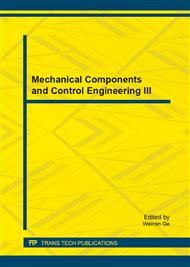p.197
p.201
p.205
p.209
p.213
p.217
p.221
p.226
p.230
Modification of Finite Element Modeling and Analysis on Various Factors of Rupture during Square Plansifter Running
Abstract:
The rupture and its several influence factors on the short crossbeam of sieve case during square plansifter running are investigated. Aimed at the system consisting of a square plansifter and some suspenders, the FEM is employed to establish structure dynamic model for obtaining dynamic response. According to the contrast of the vibration data of sieve body in experiment and the displacement response from FEA, the finite element model is modified. Results show that the position where the maximum stress happens in FEA and the position of actual rupture are the same. Furthermore, the influence of various factors on the maximum stress of three dangerous positions are computed and analyzed. The results presented in this paper possess an important reference value to structural improvement and dynamic optimization of square plansifter.
Info:
Periodical:
Pages:
213-216
Citation:
Online since:
October 2014
Authors:
Keywords:
Price:
Сopyright:
© 2014 Trans Tech Publications Ltd. All Rights Reserved
Share:
Citation:


